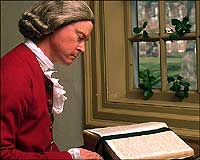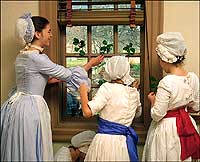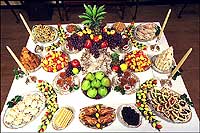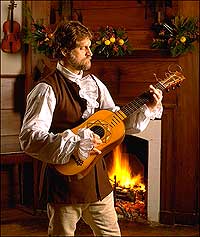Page content
Another Look at Christmas in the Eighteenth Century
By David DeSimone
How did people in eighteenth-century Virginia prepare for Christmas? There are many ways to prepare for any holiday, but a good start might be to look seriously at how eighteenth-century people prepared spiritually to celebrate Christmas. The Christmas season is foreshadowed by the four-week season of Advent. Advent is the beginning of the Christian liturgical year and is considered to be a separate season from Christmas. For most of Virginias devout Anglicans, the season of Advent was a penitential time of reflection, anticipation, and expectation for the coming of Christ. This spiritual preparation was reflected most clearly in the liturgy and prayers of the church during Advent. The daily and Sunday readings from the Book of Common Prayer are highlighted by the two great heralds of Christ-- the prophet Isaiah and John the Baptist. Fasting, the consumption of only one full meal (often meatless) during the day, was recommended as another form of self-examination in preparation for Christmas. The Advent season emphasized the timeless dialogue between darkness and light, evil and good. Perhaps at a time of the year when daylight is at an ebb, the joy of the expectation of the holiday became even greater for people of the past. Philip Fithians keen observation of December 18, 1773, strongly indicated a season of expectation:

When it grew to dark to dance. . . . we conversed til half after six; Nothing is now to be heard of in conversation, but the Balls, the Fox-hunts, the fine entertainments, and the good fellowship, which are to be exhibited at the approaching Christmas.
2. Were Christmas decorations a common sight in churches and homes? Yes. Although today residents in the Historic Area spend countless hours creating those beautiful natural decorations, greatly admired and copied far and wide, they are an inaccurate re- creation of eighteenth-century customs and materials. Citrus fruits such as oranges, lemons, and limes would never have been wasted on any form of decoration. A pineapple was considered a precious commodity in the eighteenth century and would not have been used as a door or mantel centerpiece. What was common, however, was the "sticking of the Church" with green boughs on Christmas Eve. Garlands of holly, ivy, mountain laurel, and mistletoe were hung from the church roof, the walls, and the church pillars and galleries. The pews and the pulpit, and sometimes the altar, were bedecked with garlands. This scene is described by Peter Kalm, a Swede who visited Philadelphia in 1749. On Christmas Day he wrote:
Nowhere was Christmas Day celebrated with more solemnity than in the Roman Church. Three sermons were preached there, and that which contributed most to the splendor of the ceremony was the beautiful music heard to-day. . . . Pews and altar were decorated with branches of mountain laurel, whose leaves are green in winter time and resemble the (cherry laurel).

Lavender, rose petals, and pungent herbs such as rosemary and bay were scattered throughout the churches, providing a pleasant holiday scent. Scented flowers and herbs were chosen partially because they were aromatic and thus were considered an alternative form of incense. The Reverend George Herbert, an Anglican clergyman from Maryland, urged "that the church be swept, and kept clean without dust, or cobwebs, and at great festivals strewed, and stuck with boughs, and perfumed with incense." Virginians decorated homes in the same way, but they most likely reserved one or two main rooms in the house for the Christmas observance.
3. How long was the Christmas season? The holiday, or more accurately the holy days of Christmas/Epiphany, fall into a forty- day cycle. This cycle was (and still is) a commemoration of the infancy narratives found in the Gospels of Saint Luke and Saint Matthew. Four major events involving Jesus, Mary, and Joseph are commemorated in the forty-day cycle. They are:
- December 25: The Nativity of Jesus
- January 1: The Circumcision of Jesus (Eight Days after Christmas)
- January 6: The Epiphany of Jesus (Twelve Days after Christmas)
- February 2: The Purification of the Virgin (Forty Days after Christmas)
Some of the most sacred holy days are observed within the octave of Christmas. The octave week (an eight-day observance) began on Christmas Day and included December 26-- Saint Stephens Day; December 27--Saint John the Evangelists Day; and December 28--Holy Innocents Day. The octave week festival ended with the Feast of the Circumcision on January 1. It cannot be emphasized enough that amid the joy of the season, the holy days of Saint Stephen and the Holy Innocents were a solemn reminder of the darker side of humanity. In fact, Saint Stephen and the Holy Innocents were martyred because of Christs coming. The observance of the first four sacred holy days is reflected in Fithians diary entry of December 29, 1773:
"This Morning our School begins after the Holidays. . . . At Dinner we had the Company of Dr. Franks. . . . We had a large Pye cut to Day to signify the Conclusion of the Holidays."

While the observance of these sacred days was over, it did not signal the end of the liturgical season of Christmas. Eight days after Christmas, January 1, was the celebration of the Circumcision of Christ. Twelve days after Christmas was the Feast of the Epiphany, or the manifestation of Christ to the Gentiles. Finally, forty days after Christmas was the Feast of the Purification of the Virgin Mary.
4. Why did the Masons hold special celebrations on December 27? December 27 is the feast of Saint John the Apostle and Evangelist. Saint John is one of the two patron saints of the Masonic order (along with Saint John the Baptist). Throughout Europe and the English colonies members of the Masonic order celebrated Saint Johns Day with special activities in towns and villages. In Virginia, it was customary for the Masons (dressed in full Masonic regalia) to hold a procession from their lodge building to the local parish church on Saint Johns Day. The Anglican liturgy for Saint Johns Day was observed at church but the Masons usually heard a special sermon that invoked the blessings of love, unity, fraternity, wisdom, and brotherhood. These are the qualities associated with Saint John. The sermons were often delivered by Anglican clergymen who were themselves members of the Masonic order. After the service the Masons continued to celebrate Saint Johns Day by attending a special ball and supper with their wives and friends. A fellow brother was assigned to organize the evening celebrations that were often held in local taverns or in private homes. In 1778, the preparation for Saint Johns Day came early as indicated by the minutes of the Williamsburg Lodge: (note the reverence for the Sabbath--Sunday after Christmas Day).
December 1, 1778
- On a motion made respecting the ensuing Saint John the Evangelist it was after mature consideration resolved that as that Feast falls on Sunday the usual Ceremonies be postponed until Monday.
- Resolved: That this Lodge meet on Monday after the ensuing Saint John and go in procession to Church and that the Reverend Brother Madison (James) be requested to preach a sermon on the occasion.
- Resolved: That this Lodge meet on Monday Afternoon to spend the Evening together and that a Ball be given to the Ladies and that Brother Charlton (Edward) be desired to provide accordingly.
Visiting Fredericksburg on December 27, 1774, John Harrower, a Scottish tutor, noted in his journal: "St Johns Day. This Day a Grand Lodge in Town, And the whole went to Church in their Clothing & heard Sermon."
5. How popular were Christmas music, carols, and hymns? Very popular! The Christmas season in Virginia was filled with festive entertainment, which included singing and dancing to the accompaniment of musicians. Traditional carols and contemporary hymns were sung in the company of friends and family. On Christmas Eve in 1775, Philip Fithian wrote in his diary from Staunton, Virginia:
The Evening I spent at Mr. Guys--I sung for an Hour, at the good Peoples Desire, Mr. Watts admirable Hymns--I myself was entertaind; I felt myself improvd; so much Love to Jesus is set forth--So much divine Exercise.
Fithian sang the hymns of Isaac Watts (1674-1748), an English Congregationalist minister and theologian. Wattss hymns, and his hymn book, were a favorite of many Virginians including the slaves. Expressing the popularity of Wattss hymns among the slaves was the Reverend John Wright, a Presbyterian minister active in Cumberland County, Virginia, during the 1760s. On the Feast of the Epiphany, 1761, he wrote to several benefactors in England and described the following Christmas scene:
My landlord tells me, when he waited on the Colonel [Cary] at his country-seat two or three days [ago], they heard the Slaves at worship in their lodge, singing Psalms and Hymns in the evening, and again in the morning, long before break of day. They are excellent singers, and long to get some of Dr. Wattss Psalms and Hymns, which I encourage them to hope for.

Perhaps Wattss most famous hymn is "Joy to the World," a beloved Christmas carol. During the Christmas season Virginians enjoyed singing popular English carols. Among them were "The Snow Lay on the Ground," "The First Noel," "God Rest You Merry Gentlemen," "The Holly and the Ivy," "I Saw Three Ships," and, appropriately sung on the Feast of the Holy Innocents, "Lully Lullay" ("The Coventry Carol"). During the eighteenth century carols were not sung in the liturgy of the Anglican Church. The congregation joined with the parish clerk and priest in the metrical singing of psalms and hymns based on the psalter. However, it was not unusual for Anglican clergymen to compose their own hymns for congregational singing on important feast days such as Christmas, Easter, Whitsunday, and Ascension Day. A Christmas hymn for metrical singing was composed by the Reverend James Marye in the early 1770s. Marye was rector of Saint Georges Parish in Fredericksburg from 1768 to 1780. The hymn, composed in the form of a poem, reads:
Assist me, Muse divine! To sing the Morn
On which the Saviour of Mankind was born
But oh! What Numbers to the Theme can rise?
Unless kind Angels aid me from the skies?
Methinks I see the tuneful Host descend
And with officious Joy the Scene attend.
Hark, by their hymns directed on the Road,
The gladsome Shepherds find the nascent God!
And view the Infant conscious of his Birth,
Smiling bespeak Salvation to the Earth!
6. Was Christmas celebrated throughout all the colonies? No. The celebration of Christmas was outlawed in most of New England. Calvinist Puritans and Protestants abhorred the entire celebration and likened it to pagan rituals and Popish observances. In 1659, the General Court of Massachusetts forbade, under the fine of five shillings per offense, the observance "of any such day as Christmas or the like, either by forebearing of labour, feasting, or any such way." The Assembly of Connecticut, in the same period, prohibited the reading of the Book of Common Prayer, the keeping of Christmas and saints days, the making of mince pies, the playing of cards, or performing on any musical instruments. These statutes remained in force until they were repealed early in the nineteenth century. In 1749, Peter Kalm noted that the Quakers completely dismissed the celebration of Christmas in Philadelphia. Kalm made another interesting observation about the Presbyterians as well. He wrote in his diary:
Christmas Day. . . .The Quakers did not regard this day any more remarkable than other days. Stores were open, and anyone might sell or purchase what he wanted. . . .There was no more baking of bread for the Christmas festival than for other days; and no Christmas porridge on Christmas Eve! One did not seem to know what it meant to wish anyone a merry Christmas. . . .first the Presbyterians did not care much for celebrating Christmas, but when they saw most of their members going to the English church on that day, they also started to have services.
Christmas Day in 1775 must have been a great disappointment for the Presbyterian missionary, Philip Fithian. A year earlier he had experienced the finest of Virginia Christmases the residence of Robert Carter, Nomini Hall. But in 1775, Fithian toiled as a missionary in the western counties of Virginia among the Scotch and Scotch-Irish Presbyterians. The following is part of his diary entry for December 25:
Christmas Morning--Not A Gun is heard--Not a Shout--No company or Cabal assembled--To Day is like other Days every Way calm & temperate-- People go about their daily Business with the same Readiness, & apply themselves to it with the same Industry.
Anglicans, Roman Catholics, Lutherans, and Moravians celebrated the traditional Christmas season with both religious and secular observances. These celebrations in eighteenth- century America were observed by the aforementioned communities in cities such as New York and Philadelphia, in the Middle Atlantic colonies of New York, Pennsylvania, and Maryland, and in the South.
This article is reprinted from The Colonial Williamsburg Interpreter, vol. 16, no. 4, winter 1995-96.
